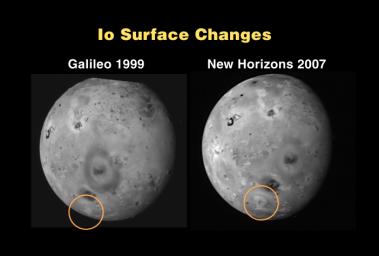
|
Io Surface Changes
- Click the image above for a larger view
- Full-Res JPEG (3000 x 2025) (261.5 kB)
- Full-Res TIFF (3000 x 2025) (18.2 MB)
Caption:
This montage compares similar sides of Io photographed by the Galileo spacecraft in October 1999 (left) and the New Horizons spacecraft on February 27, 2007. The New Horizons image was taken with its Long Range Reconnaissance Imager (LORRI) from a range of 2.7 million kilometers (1.7 million miles).
Most features on Io have changed little in the seven-plus years between these images, despite continued intense volcanic activity. The largest visible feature is the dark oval composed of deposits from the Pele volcano, nearly 1,200 kilometers (750 miles) across its longest dimension. At high northern latitudes, the volcano Dazhbog is prominent as a dark spot in the New Horizons image, near the edge of the disk at the 11 o'clock position. This volcano is much less conspicuous in the Galileo image. This darkening happened after this 1999 Galileo image but before Galileo took its last images of Io in 2001.
A more recent change, discovered by New Horizons, can be seen in the southern hemisphere (circled). A new volcanic eruption near 55 degrees south, 290 degrees west has created a roughly circular deposit nearly 500 kilometers (300 miles) in diameter that was not seen by Galileo. Other New Horizons images show that the plume that created this deposit is still active.
The New Horizons image is centered at Io coordinates 8 degrees south, 269 degrees west.
Cataloging Keywords:
| Name | Value | Additional Values |
|---|---|---|
| Target | Io | |
| System | Jupiter | |
| Target Type | Satellite | |
| Mission | New Horizons | Galileo |
| Instrument Host | New Horizons | Galileo Orbiter |
| Host Type | Flyby Spacecraft | Orbiter |
| Instrument | Long Range Reconnaissance Imager (LORRI) | Solid-State Imaging (SSI) |
| Detector | ||
| Extra Keywords | Atmosphere, Color, Plume, Storm, Visual, Volcano | |
| Acquisition Date | ||
| Release Date | 2007-05-01 | |
| Date in Caption | 2007-02-27 | |
| Image Credit | NASA/Johns Hopkins University Applied Physics Laboratory/Southwest Research Institute | |
| Source | photojournal.jpl.nasa.gov/catalog/PIA09355 | |
| Identifier | PIA09355 | |
